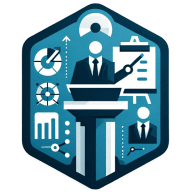How to Leverage Your Strengths to Advance Your Career: 10 Tools
Navigating a career path can often feel like traversing unknown territory, but harnessing one's innate strengths paves the way to success. This article distills expert insights into actionable tools designed to amplify self-awareness and propel professional advancement. Discover methods to assess and cultivate your unique abilities, creating a personalized blueprint for career acceleration.
- Combine Self-Reflection With Outside Input
- Use The Sparketype Assessment
- Take The CliftonStrengths Assessment
- Analyze Your Biggest Achievements
- Perform A Self-Reflective Strengths Assessment
- Complete The StrengthsFinder Assessment
- Conduct A Personal SWOT Analysis
- Take The VIA Character Strengths Assessment
- Identify Strengths With CliftonStrengths
- Reflect And Gather Feedback From Colleagues
Combine Self-Reflection With Outside Input
As an HR professional and soft skills trainer, I think the best way to discover your strengths is by combining self-reflection with outside input. One activity I've found really helpful is a simple "stop-start-continue" feedback exercise.
I asked a few colleagues, "What should I stop doing, start doing, and continue doing?" The feedback was so valuable. For example, someone told me I'm great at making people feel comfortable in group discussions and that I should do more of that in team meetings. It gave me a clear picture of what I was doing well and how I could use it more effectively.
Once you know your strengths, it's about paying attention to opportunities where you can use them more often. For me, that meant taking on more facilitation roles, which ended up helping both my confidence and my career.

Use The Sparketype Assessment
One effective way to identify and leverage your strengths is to reflect on tasks or activities that make you feel energized and confident. A great tool I always use for this is the Sparketype Assessment, which helps uncover the types of work that bring you the most fulfillment and align with your natural abilities.
After completing the assessment, I use the results to focus on career opportunities that match your strengths and passions.
For example, if your results show you excel at problem-solving or leading others, you can seek roles that allow you to showcase those skills. By aligning your career with your strengths, you'll not only perform better but also feel more engaged and satisfied with your work.
The Sparketype Assessment is a simple and actionable way to uncover what truly makes you thrive professionally.

Take The CliftonStrengths Assessment
As the Founder and CEO of Zapiy.com, I've found that identifying and leveraging personal strengths has been pivotal in advancing my career. It's all about aligning what you're naturally good at with the goals you're striving to achieve. Early on, I realized that self-awareness is the foundation of this process, and one tool that helped me immensely was the CliftonStrengths assessment.
The CliftonStrengths assessment doesn't just label your abilities; it dives into how you naturally think, feel, and behave. When I took it, my top strengths were Strategic, Futuristic, and Achiever. This clarity helped me see how I excel at envisioning long-term goals, creating actionable plans, and staying driven to execute them. Knowing this allowed me to focus on roles and projects where I could thrive rather than struggle in areas that didn't come as naturally.
For instance, when we were scaling Zapiy.com, I leaned heavily into my strategic strength to map out our growth trajectory. While I focused on the big picture, I consciously delegated operational tasks to team members whose strengths complemented mine. This wasn't just efficient—it empowered the whole team.
Beyond assessments, I also regularly reflect on feedback from peers and mentors. They often see strengths in you that you might overlook. Combining that external perspective with tools like CliftonStrengths creates a well-rounded understanding of what you bring to the table.
My advice to anyone is to not only identify their strengths but actively design their work around them. Use tools, seek feedback, and continually refine how you play to your strengths. When you do, it doesn't just advance your career—it makes the journey far more fulfilling.
Analyze Your Biggest Achievements
Identifying and leveraging your strengths starts with a deep understanding of what you naturally excel at and how those skills align with your goals. For me, the turning point was realizing that my passion for gardening, combined with years of hands-on experience and formal education, was more than just a hobby, it was a foundation for a thriving business. One assessment tool that helped me clarify my strengths was a simple but powerful exercise: listing my biggest achievements and analyzing the skills that made them possible. For example, winning a customer service award highlighted my ability to connect with clients and understand their needs, which became a core value for Ozzie Mowing & Gardening. This process helped me see that my practical expertise, theoretical knowledge, and communication skills were assets I could lean into to grow my business and reputation.
An example of this in action is when I took on a large-scale landscaping project for a community space. The project required detailed planning, problem-solving, and the ability to communicate clearly with stakeholders to bring their vision to life. My 15 years of experience and qualifications as a certified horticulturist gave me the confidence to approach the project methodically, ensuring every aspect, from soil preparation to plant selection, was executed to the highest standard. By leveraging my strengths in design, plant care, and client collaboration, the project was not only completed on time, but also became a local showcase of sustainable landscaping. This experience reinforced how identifying and playing to your strengths can drive meaningful success in your career.
Perform A Self-Reflective Strengths Assessment
Identifying and leveraging your strengths starts with a clear understanding of what you excel at and how those skills can add value in your field. For me, one of the most effective tools has been a self-reflective strengths assessment, specifically the CliftonStrengths assessment. This exercise helped me uncover my natural abilities in leadership, problem-solving, and building relationships. For example, one of my key strengths is adaptability, which is crucial in the tree service industry because no two projects are ever the same. Whether it's assessing the risks of a large oak removal or troubleshooting unexpected complications during a job, I've learned how to stay calm under pressure and pivot quickly while keeping the customer's needs at the forefront. My years of experience, combined with my TRAQ certification, have allowed me to turn what could be setbacks into opportunities to demonstrate expertise and build trust.
A real-world example of leveraging my strengths occurred during a storm emergency in the DFW area. A client called in distress after a large tree had fallen and damaged part of their roof. Thanks to my ability to assess the situation quickly and coordinate my team efficiently, we arrived within hours, safely removed the tree, and secured their property to prevent further damage. My background in the industry and the relationships I've built over 20 years helped ensure we had the tools and resources needed for a fast resolution. This moment reinforced the importance of combining technical skills, strong leadership, and empathy to exceed customer expectations. By leaning into these strengths, I've been able to advance my career and grow my business through trust and reliability.

Complete The StrengthsFinder Assessment
Identifying and leveraging your strengths starts with self-awareness and intentionally aligning your skills with opportunities that allow them to shine. One exercise I've found incredibly helpful is the StrengthsFinder assessment (now CliftonStrengths). It identifies your top talents, things you naturally excel at, and provides insights into how to develop them further. When I discovered that "Strategic" and "Activator" were among my top strengths, I focused on roles that let me create and execute big-picture plans, which felt both natural and rewarding.
Once you've identified your strengths, the key is weaving them into your career narrative. Highlight them in your resume, use them to back up your achievements during interviews, and seek out projects or roles where they add unique value. Don't just focus on improving weaknesses. Doubling down on your strengths can create a bigger impact and set you apart in your field. StrengthsFinder is a great place to start because it helps you frame what you do best and how to maximize it for career growth.

Conduct A Personal SWOT Analysis
A Founder's Personal and Professional Growth Through SWOT Analysis Approach
As the founder of a legal process outsourcing company, identifying and leveraging my strengths has been essential to building a thriving business and advancing my career.
Early on, I realized that my knack for creating efficient workflows and my passion for empowering team members were key strengths. One exercise that helped me uncover these was conducting a SWOT analysis—not just for my business but for myself.
This approach made me step back and evaluate my strengths, weaknesses, opportunities, and threats, aligning them with my personal and professional goals. For instance, when I noticed my ability to delegate effectively, I leaned into this by creating opportunities for my team to take ownership of projects, empowering them and allowing me to focus on strategic growth.
This dual benefit became a cornerstone of my leadership style. If you're looking to identify your strengths, I highly recommend the SWOT analysis—it's practical, insightful, and easily adaptable to your unique journey.

Take The VIA Character Strengths Assessment
I use the VIA Character Strengths Assessment to identify core personal strengths, such as leadership, creativity, or resilience, and help align them with career goals. By focusing on my top strengths, I've learned to approach challenges more strategically, leaning into what I naturally excel at. This drives meaningful progress in my career. It's a great exercise for self-awareness and aligning work with personal values.

Identify Strengths With CliftonStrengths
The best-performing employees know what they do well and focus on maximizing their talents in the workplace. One way to get ahead at work is to identify your strengths, then pursue career opportunities where you use them daily.
To find these, I highly recommend taking the CliftonStrengths assessment by Gallup. The results are your top five strengths based on patterns of how you behave, feel, and think in different situations. This list is especially helpful during the interview process.
By learning whether your strengths are in executing, influencing, relationship building, or strategic thinking, you can look for jobs where you will naturally succeed and continue to advance in your career as a result.

Reflect And Gather Feedback From Colleagues
Identifying and leveraging your strengths to advance your career begins with honest self-reflection and gathering feedback from trusted colleagues or mentors. Start by considering the tasks or activities that energize you and where you naturally excel. Reflect on past successes and identify patterns—what skills or qualities helped you achieve those results?
Another helpful approach is seeking feedback from colleagues, managers, or peers who can offer insights into how they perceive your contributions. Often, others can see strengths that you may overlook. For example, if people frequently comment on your problem-solving abilities or your knack for collaboration, these could be areas to focus on and develop further.
To leverage these strengths, align your career goals with roles or projects where they can shine. Advocate for opportunities where your abilities are in demand, such as leading a challenging project or mentoring others. Continuously building on your strengths not only enhances your performance but also reinforces your professional identity, making you a sought-after contributor in your field.




